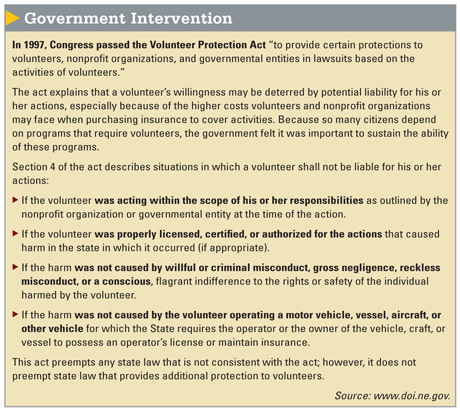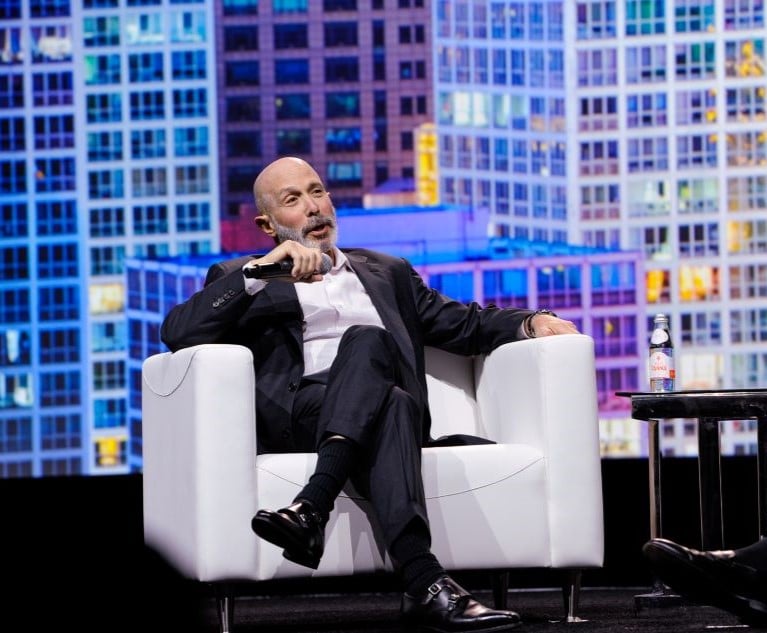 America is a nation of volunteers. We volunteer forpolitical campaigns, social and charitable functions, andwork-related events. Most of this volunteering is done without anythought as to liability consequences; for example, who is liable for certain acts or omissions that cause injuryor damage to the volunteer or others. If we use a volunteer, JohnQ. Public, as an example, then perhaps the potential consequencesof volunteering will be made clearer.
America is a nation of volunteers. We volunteer forpolitical campaigns, social and charitable functions, andwork-related events. Most of this volunteering is done without anythought as to liability consequences; for example, who is liable for certain acts or omissions that cause injuryor damage to the volunteer or others. If we use a volunteer, JohnQ. Public, as an example, then perhaps the potential consequencesof volunteering will be made clearer.
In the first scenario, Public has volunteered to build housesfor a local humanitarian society. While constructing the house,Public accidentally shoots a fellow volunteer with a nail gun,backs his car over the foot of a curious passerby, and puts fivestaples from a power stapler into his own hand. After leaving thehospital, Public goes home to ponder his situation.
|Presuming that the local humanitarian organization has noliability insurance, Public must look to his own insurancecoverages. Public's homeowners' policy offers him liabilitycoverage for damages because of bodily injury caused by anoccurrence. There is an exclusion on his policy for injury arisingout of or in connection with a business engaged in by an insured.Now, “business” is defined in the standard homeowners' policy as atrade, profession, or occupation engaged in on a full-time,part-time, or occasional basis. Whether this description fitsPublic is debatable, because he actually makes his living as ateacher. Moreover, the policy goes on to state that a business doesnot include volunteer activities for which no money is received,other than payment for expenses incurred to perform the activity.So, if the fellow volunteer sues Public for the injury, thenPublic's homeowners' policy will provide liability coverage.
|As for the injury to the passerby, Public's personal auto policy(PAP) applies to injury for which any insured becomes legallyresponsible because of an auto accident. An injury occurred in thiscase, the insured is liable, and there are no exclusions on the PAPto prevent auto liability coverage. Public's status as a volunteerdoes not affect his PAP liability coverage.
|Since the organization for which Public was performing serviceshas no general liability policy, there is no question here aboutpossible coverage of medical payments for Public's hand injury.Public must rely on his own health insurance for the cost of hiscare.
|The Tables Turn
Now, if the humanitarian group does have liabilityinsurance, then the situation changes somewhat. Under the currentcommercial general liability (CGL) coverage form, Public, as avolunteer, is an insured while performing duties related to theconduct of the named insured's business. However, volunteers arenot insured for injury to other volunteer workers while performingduties related to the business. So, Public would have no generalliability coverage for injuring his fellow volunteer. The CGL form excludes injury arising out of theownership or use of any auto owned or operated by any insured.Public is an insured under the group's CGL form, so the autoexclusion prevents any coverage for Public for backing his car overthe passerby's foot. Public's personal auto policy is still theplace to look for liability coverage in this instance.
The group's CGL form will provide medical payments coverage forthe injury Public caused to himself since his injury was caused byan accident due to the operations of the named insured. The formdoes exclude coverage for injury to any insured except forvolunteers such as Public.
|Volunteering for Pay
Consider another scenario. Public is a member of a local chapter ofthe National Parent Teacher Association (PTA). Although hevolunteers at an amusement park, performing as a paidemployee, the PTA collects the compensation that wouldnormally be due to him. Public does not directly receive a paycheckor any type of wage statement from the park. While at work onenight, Public accidentally hits a customer with a bag of ice,loudly accuses another customer of trying to steal money from thetill, and trips over a pile of boxes he threw in the back of thesoft drink booth, breaking his leg. While recuperating in thehospital, Public learns that he is being sued by the two customersand is handed a $5,000 hospital bill. Public then begins to wonderwhat his insurance may cover.

Concerning the lawsuits filed against him,Public has at least three liability policies that may provide somecoverage.
|In this situation, liability coverage provided by hishomeowners' policy has to be seen in connection with the businessexclusion discussed previously. Coverage for injury arising out ofor in connection with a business engaged in by an insured isexcluded by the policy. Public cannot use the volunteer exceptionfound in the “business” definition because money was received.However, there is an exception in the definition that may help:Work performed for a business does not include an activity forwhich the insured receives no more than $2,000 in totalcompensation for the 12 months prior to the when the policy began.If Public did not receive any payments from the amusement parkprior to this particular event, then the business exclusion wouldnot affect Public's liability coverage under his homeowners' policyfor the injury claim. However, coverage applies to bodily injuryand the definition of bodily injury in the policy does not includeinjury arising out of insults or slander. Thus, Public's slanderingof the customer as a thief is an offense not covered by thehomeowners' policy.
|The park's liability policy would apply to Public if he wereconsidered an employee of the park or a volunteer (or if he wereadded as an insured through an endorsement). As an employee orvolunteer, he would be covered because he was performing dutiesrelated to the conduct of the park's business when he injured onecustomer and publicly slandered another. His status as an employeecan be disputed, though, since he was not actually paid by the parkand there was no employment contract. Public's status as avolunteer, however, is a bit more defined because he donated hisservices, was working at the direction of and with in the scope ofduties determined by the park, and was not paid or compensated byanyone for his work.
|The third liability policy to consider is the PTA's policy.Public can be considered a volunteer, thus considered an insuredunder the terms of the policy, because he was performing activitieson behalf of the PTA and working so that the PTA could receive thebenefits of his labor. The PTA's liability policy would owe Publicdefense and indemnity.
|The liability for Public's own injury, however, depends mostlyon his status in relation to the park and to the PTA. If he isconsidered an employee, then he has no coverage under eitherentity's general liability policy; this would be a workers'compensation issue. But, as a volunteer, med pay coverage isavailable to Public under both policies.
|In summary, people may be giving more than their time and effortwhen they become volunteers. Although volunteerism is a wonderfulthing, charitable souls need to be aware of the risks that theyface in assuming the role.
Want to continue reading?
Become a Free PropertyCasualty360 Digital Reader
Your access to unlimited PropertyCasualty360 content isn’t changing.
Once you are an ALM digital member, you’ll receive:
- All PropertyCasualty360.com news coverage, best practices, and in-depth analysis.
- Educational webcasts, resources from industry leaders, and informative newsletters.
- Other award-winning websites including BenefitsPRO.com and ThinkAdvisor.com.
Already have an account? Sign In
© 2024 ALM Global, LLC, All Rights Reserved. Request academic re-use from www.copyright.com. All other uses, submit a request to [email protected]. For more information visit Asset & Logo Licensing.








